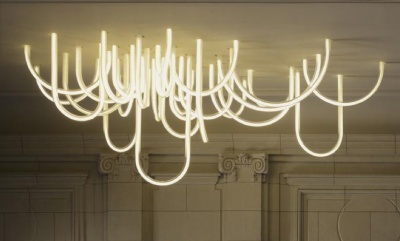 Designer Mathieu Lehanneur’s lighting installation “Les Cordes” contrasts with the historic enivronment of thereopened Château Borély in Marseille, France.
Designer Mathieu Lehanneur’s lighting installation “Les Cordes” contrasts with the historic enivronment of thereopened Château Borély in Marseille, France.
Light-emitting diode, or LED lighting stands in direct contrast with the lighting that most of us are used to. Unlike household incandescent bulbs that emit large quantities of heat and burn out quickly, LED illumination operates with remarkable energy efficiency and durability. Televisions, light bulbs, and computer displays have been making use of LED for years. In response to government mandates and improving technology, designers are exploring this technology as not just a new form of lighting, but one with new possibilities for creative expression. Case in point is French designer Mathieu Lehanneur, whose recent installation, Les Cordes, christened the newly reopened Château Borély in Marseille. Working with only the materials of LED light, glass tubes, and a lighting control system, Lehanneur designed and created a modern, more abstract take on the chandelier.
 Slumped borosilicate tubes filter LED lighting strands to create a look as if light itself is dripping from the ceiling.
Slumped borosilicate tubes filter LED lighting strands to create a look as if light itself is dripping from the ceiling.
Les Cordes hangs elegantly but seems out of place in juxtaposition with the 18th century manor. Geometric and rounded shapes protrude from the ceiling at varying lengths, giving the installation a sense of depth. At first glance, the closeness of the glass tubes gives a sense of chaos, but upon a closer look the shapes seem meticulously, almost mathematically organized. To create the piece, glass tubes were placed in a kiln to wilt, then bent at various curves and angles. The different lengths and shapes of the tubes give the chandelier the feeling of falling from the ceiling due to the sheer force of gravity. The tubes could have been filled with neon, but the resulting light would have been diffuse with tubes of that width, and the light would not have been even around the many curves. Packed with several strands of LED lights, Les Cordes emits a strong, even white light.
 Mathieu Lehanneur, pictured here holding his Cloudy Lamp, uses glass to diffuse the sometimes cold light of LED technology.
Mathieu Lehanneur, pictured here holding his Cloudy Lamp, uses glass to diffuse the sometimes cold light of LED technology.
With such attention to details, it should come as no surprise that Lehanneur is heavily influenced by science. At a TED talk in 2009 on science-inspired design, Lehanneur, showcases some of his most unique works, including an antibiotic pill with layers that get smaller as the regimen continues and a ball that eliminates white noise. Recent projects also showcase Lehanneur’s commitment to LED lighting, including his recent installation at Electric, a hip new space in Paris that overlooks the Eiffel Tower, features light projectors and glass tubes similar to those found in Les Cordes dangling from a tree that spans two floors. Another project, Cloudy Lamp, emits LED through gradient glass and slowly transitions from translucent to transparent.
These light installations all would not have been possible without the use of LED light. Its compact, comparatively cool nature makes it a material that is being seen much more frequently in design. In addition, its long lifespan (some 40% longer than traditional incandescent bulbs) make for design that is built to last and eco-friendly, two checkmarks on the modern designers’ list of requirements.
—Vaughn Watson
For more on Lehanneur’s Les Cordes project, including some technical information on its manufacture, see the video below.
[vimeo http://vimeo.com/67508313]


